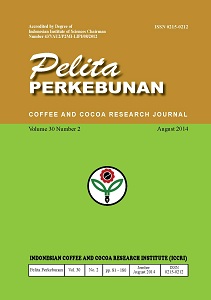The side effect of Paecilomyces fumosoroseusapplication on the black ant, Dolichoderus thoracicus, the predator of Helopeltis antoniiand cocoa pod borer

Article Sidebar

PDF

Published
May 1, 2006
DIMENSION
ALTMETRIC
Main Article Content
Endang Sulistyowai
Pusat Penelitian Kopi dan Kakao Indonesia
Endang Mufrihati
Pusat Penelitian Kopi dan Kakao Indonesia
Bekti Andayani
Universitas Jember
Abstract
Paecilomyces fumosoroseuswas known as one of the effective biological agents of cocoa pod borer and Helopeltis antonii. To find out the side effect of application of P. fumosoroseuson black ant, Dolichoderus thoracicus, a series of observations were carried out at the Laboratory of Pest and Diseases Indonesian Coffee and Cocoa Research Institute (ICCRI) and in a cocoa plantation of Glenmore, Banyuwangi district, since June until October, 2004. Laboratory research used four concentrations of P. fumosoroseusnamely 105, 106, 107 and 108 spores/ml, while in the field used concentration 2, 4, 6, 8 g dry spores/ml. Each trial as compared with spraying of carbamate and synthetic pyrethroid insecticides as control and untreated This research was designed by randomized block design and four replications. The results showed that in the laboratory, direct spraying suspension of P. fumosoroseuskilled black ant between 20—39% which infected fungi about 2.5—12.5%. The relationship between log of spores concentration of P. fumosoroseus and probit of ant mortality followed the regression equation Y = 3.653 + 0.097 X with LC 50 was 8 x 10 13 spore/ml. The period needed to kill a half of ant population at the laboratory (LT 50) at concentration 107 spores/ml followed the regression equation Y = 1.851 + 1.522 X, with LT50 is 12,01 days. The effect of pyrethroid and carbamate insecticide on ants mortality were 91.25% and 98.75% respectively. In the field, the effect of P. fumosoroseusspray on black ant population was very low, with the percentage of ant mortality at cocoa leaf nest were 0.25–0.46% and at cocoa leaf nest in plastic bag were 0.06–0.21%, while carbamate and pyrethroid synthetic effect were 37.35% and 52.37% at cocoa leaf nest, and 19.15% and 46.67% at cocoa leaf nest in plastic bags. Key words : Cocoa, capsid, Helopeltis antonii, biological control, biological agents, Paecilomyces fumosoroseus, Dolichoderus tharacicus.
Article Details
How to Cite
Sulistyowai, E., Mufrihati, E., & Andayani, B. (2006). The side effect of Paecilomyces fumosoroseusapplication on the black ant, Dolichoderus thoracicus, the predator of Helopeltis antoniiand cocoa pod borer. Pelita Perkebunan (a Coffee and Cocoa Research Journal), 22(2). https://doi.org/10.22302/iccri.jur.pelitaperkebunan.v22i2.36
Issue
Section
Articles

This work is licensed under a Creative Commons Attribution-NonCommercial 4.0 International License.
Authors who publish with this journal agree to the following terms:
- Authors retain copyright and grant the journal right of first publication with the work simultaneously licensed under a Creative Commons Attribution License that allows others to share the work with an acknowledgement of the work's authorship and initial publication in this journal.
- Authors are able to enter into separate, additional contractual arrangements for the non-exclusive distribution of the journal's published version of the work (e.g., post it to an institutional repository or publish it in a book), with an acknowledgement of its initial publication in this journal.
- Authors are permitted and encouraged to post their work online (e.g., in institutional repositories or on their website) prior to and during the submission process, as it can lead to productive exchanges, as well as earlier and greater citation of published work (See The Effect of Open Access).
Most read articles by the same author(s)
- Endang Sulistyowati, Suryo Wardani, Endang Mufrihati, Development of Monitoring Technique for Cocoa Pod Borer(Conopomorpha cramerella Snell.) , Pelita Perkebunan (a Coffee and Cocoa Research Journal): Vol 21 No 3 (2005)
- Retno Hulupi, Mulyadi ., Bekti Andayani, Distribution of Radopholus similisand Pratylenchus CoffeaeNematodes in Coffee Plantation , Pelita Perkebunan (a Coffee and Cocoa Research Journal): Vol 23 No 3 (2007)
